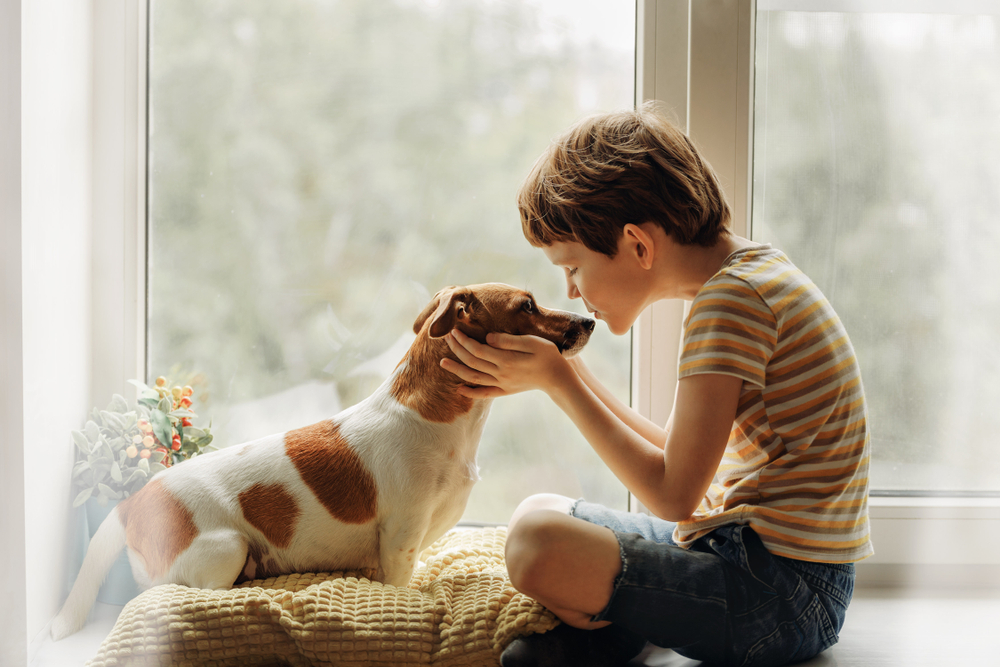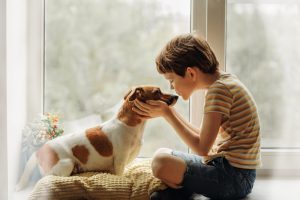Children and pets are two of life’s greatest joys, and together, they’re so cute, they make our hearts burst! But as any parent who also owns a pup can tell you, facilitating that first meeting between human children and fur children isn’t always easy. That’s especially true for Dog Owners whose pooches aren’t exactly known for being calm and gentle. Still, in the long run, studies show a strong bond between kids and pooches is mutually beneficial, leading to stronger social skills in children and a better-socialised pup.
So, how do you introduce kids to dogs the right way, whether it’s your own pup or one you’re Pet Sitting? With our guide, you’ll have an inseparable pair of besties on your hands in no time!
How to introduce kids to dogs
Step 1: Preparation
As with most things in life, preparation is key when introducing kids to dogs. There are two main ways to prepare for the big meeting, and both are essential.
First, you’ll want to give your (human) child a crash-course in responsible dog handling. For very young kids, this means ensuring they understand that your pup isn’t a toy. Teach them how to gently pat the dog and make sure they know to avoid pulling their tail or ears before the introduction. If your fur baby knows commands like sit, stay, and come, you may also want to share these with your child so they can give it a go themselves.
Now that your little one has all the basics down, it’s all about creating the right environment for the meeting. Any time you introduce your pup to something new, you’ll want to do so in a calm, quiet way that allows the dog to do things on their own terms. With that in mind, it’s best to give them a way out, so they can leave the interaction at any time. Also, having plenty of treats on hand is a sure-fire way to help make it a fun experience for your furry friend.
Step 2: Start small and take it slow
Though the first meeting can be incredibly exciting, it’s important to take things slow at first. After all, you don’t want to overwhelm your pup!
First things first, let your doggo approach your child in their own time. Ask your child to remain calm and relatively still, allowing the pup to approach. There’ll probably be lots of sniffing, which is a good thing – it’s your dog’s way of getting to know everyone, including kids.
As the adult, you’ll want to keep a close eye on both kid and pup. If your dog begins exhibiting any signs of annoyance or perhaps overexcitement, be prepared to step in. Likewise, if your pooch is behaving like an absolute angel, be sure to reward them with a treat. In doing so, your pup will begin associating being calm around children with something positive.
Step 3: BFFs!
Now that they’ve met (and all has hopefully gone to plan!) it’s a good idea to repeat the process a few times. It won’t take long at all for them to build mutual trust and a solid bond. After those first few meetings, your child can then join you and your dog on walks, play fetch, and do all the fun things that come with being a Pet Owner!
5 tips for introducing kids to dogs
So, we’ve got the step-by-step process down pat, but there are still a few things to keep in mind when it comes to introducing kids to dogs.
Here are some tips to help make the meeting a success.
- Keep your pup on a lead. For the first meeting, consider keeping your dog on a lead – especially if you’ve got a big, boisterous pooch on your hands. Having that control means you should be able to rein them in if they get a little overexcited.
- Turn the volume down. The first introduction can be overwhelming for both your child and your dog. Though you can’t necessarily control your dog’s barking, ensuring that you and your kid speak softly (no screams or super loud laughter) can help make your pup feel a little more comfortable.
- Avoid hugs. A child hugging a dog is just about the cutest thing in the world, but for our furry friends, they’re not always welcome. In fact, hugs can make dogs feel trapped and anxious, so it’s best to stick to pats and tummy scratches at first.
- Observe your dog’s body language. Like us, dogs say a lot with their body language and facial expressions. Keep an eye out for any signs of stress or anxiety (such as downturned ears, half-moon eyes, eye contact avoidance, yawning, and excessive licking) as your pup may be telling you they’ve had enough for today.
- Never leave a child unattended with your dog. Even the gentlest, sweetest pups in the world can get annoyed from time to time, and on rare occasions, that annoyance can turn into aggression. To protect your child, ensure there is always at least one grown-up watching over them and the dog.


